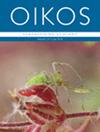The origin of excavator nesting behavior and its impact on the evolution of Neotropical parrots
IF 3
2区 环境科学与生态学
Q2 ECOLOGY
引用次数: 0
Abstract
How the origin of novel behaviors can shape the evolutionary trajectory of organisms in response to environmental change remains poorly understood. Birds, especially those with big brains like parrots, are benchmarks for their behavioral innovation capacity in novel environments. Here, we assess whether and how the emergence of open areas in the Neotropics that started in the middle Miocene influenced the evolution of nesting behavior in parrots and how they triggered changes in other life-history traits. To address these questions, we use a phylogenetic-based analyses of trait evolution in the subfamily Arinae (Neotropical parrots), focusing on habitat, nesting behavior, morphology, and life-history traits (clutch size, incubation period and fledging period). Evolutionary reconstructions show that transitions to excavating behavior mostly happened when species colonized open areas, providing evidence that this behavior originated in open environments. Evolutionary models suggest that the new open areas and the excavator nesting behavior exerted new selective pressures on morphology and life-history traits, leading to evolutionary changes towards larger clutch sizes and shorter fledging periods in excavator parrots. Our study indicates that excavator nesting behavior in Neotropical parrots has likely played a key role in allowing them to exploit the ecological opportunities available in newly formed open biomes.挖掘机筑巢行为的起源及其对新热带鹦鹉进化的影响
人们对新行为的起源如何影响生物的进化轨迹以应对环境变化仍然知之甚少。鸟类,尤其是像鹦鹉这样的大脑袋鸟类,是新环境中行为创新能力的标杆。在这里,我们将评估中新世中期开始的新热带地区开阔地带的出现是否以及如何影响了鹦鹉筑巢行为的进化,以及如何引发了其他生活史特征的变化。为了解决这些问题,我们利用基于系统发生学的方法分析了有尾亚科(新热带鹦鹉)的性状进化,重点研究了栖息地、筑巢行为、形态和生活史性状(窝产仔数、孵化期和羽化期)。进化重建显示,挖掘行为的转变大多发生在物种殖民到开阔地区的时候,这为这种行为起源于开阔环境提供了证据。进化模型表明,新的开阔地区和挖掘筑巢行为对鹦鹉的形态和生活史特征产生了新的选择性压力,导致挖掘筑巢鹦鹉在进化过程中出现了窝产蛋量增大和羽化期缩短的变化。我们的研究表明,新热带鹦鹉的挖掘筑巢行为很可能在使它们能够利用新形成的开阔生物群落中的生态机会方面发挥了关键作用。
本文章由计算机程序翻译,如有差异,请以英文原文为准。
求助全文
约1分钟内获得全文
求助全文
来源期刊

Oikos
环境科学-生态学
CiteScore
6.20
自引率
5.90%
发文量
152
审稿时长
6-12 weeks
期刊介绍:
Oikos publishes original and innovative research on all aspects of ecology, defined as organism-environment interactions at various spatiotemporal scales, so including macroecology and evolutionary ecology. Emphasis is on theoretical and empirical work aimed at generalization and synthesis across taxa, systems and ecological disciplines. Papers can contribute to new developments in ecology by reporting novel theory or critical empirical results, and "synthesis" can include developing new theory, tests of general hypotheses, or bringing together established or emerging areas of ecology. Confirming or extending the established literature, by for example showing results that are novel for a new taxon, or purely applied research, is given low priority.
 求助内容:
求助内容: 应助结果提醒方式:
应助结果提醒方式:


